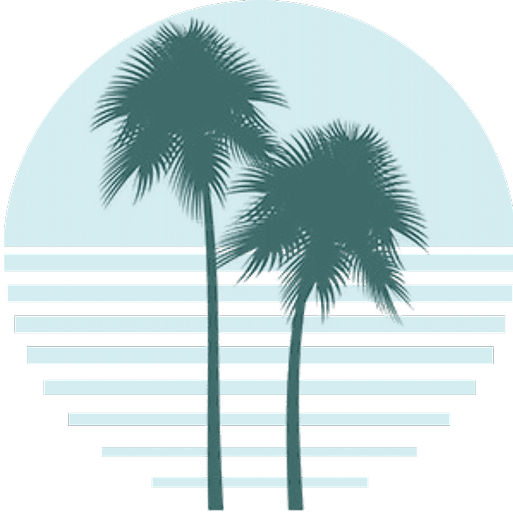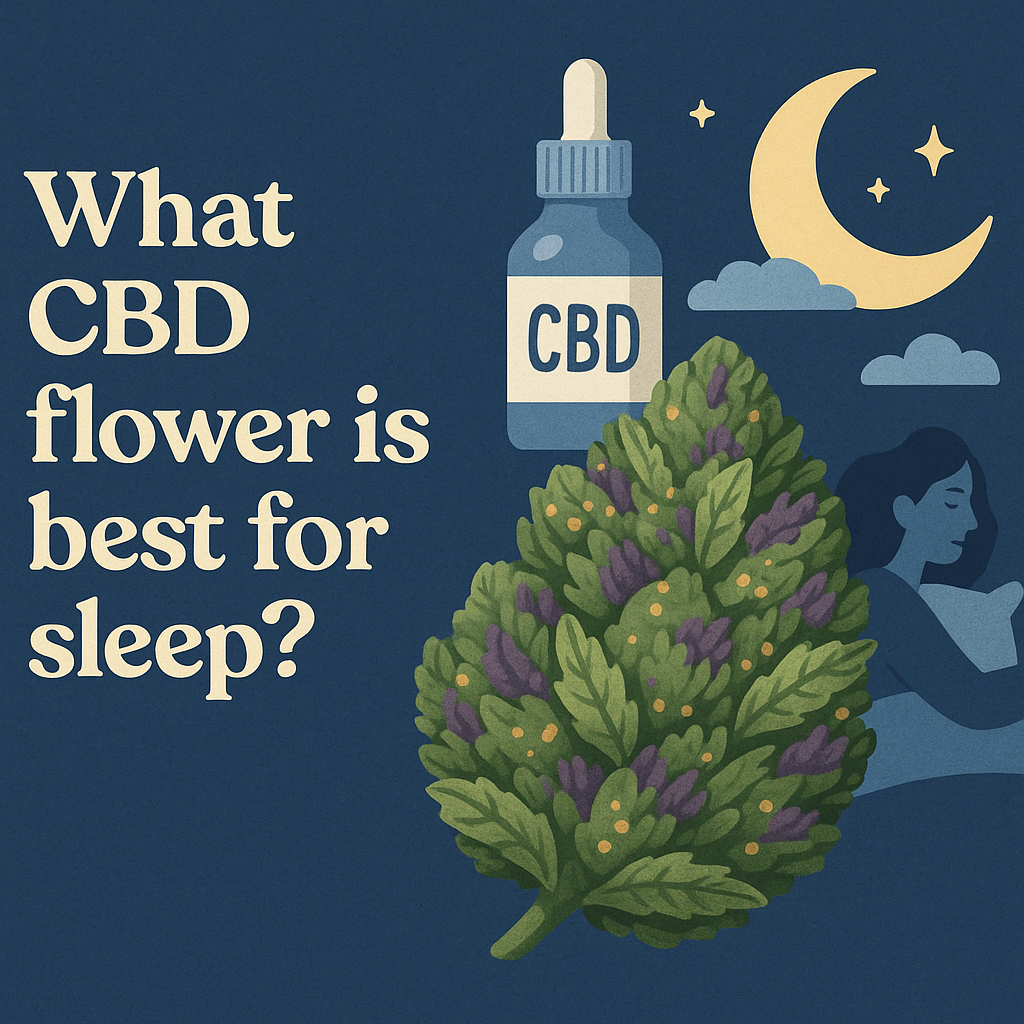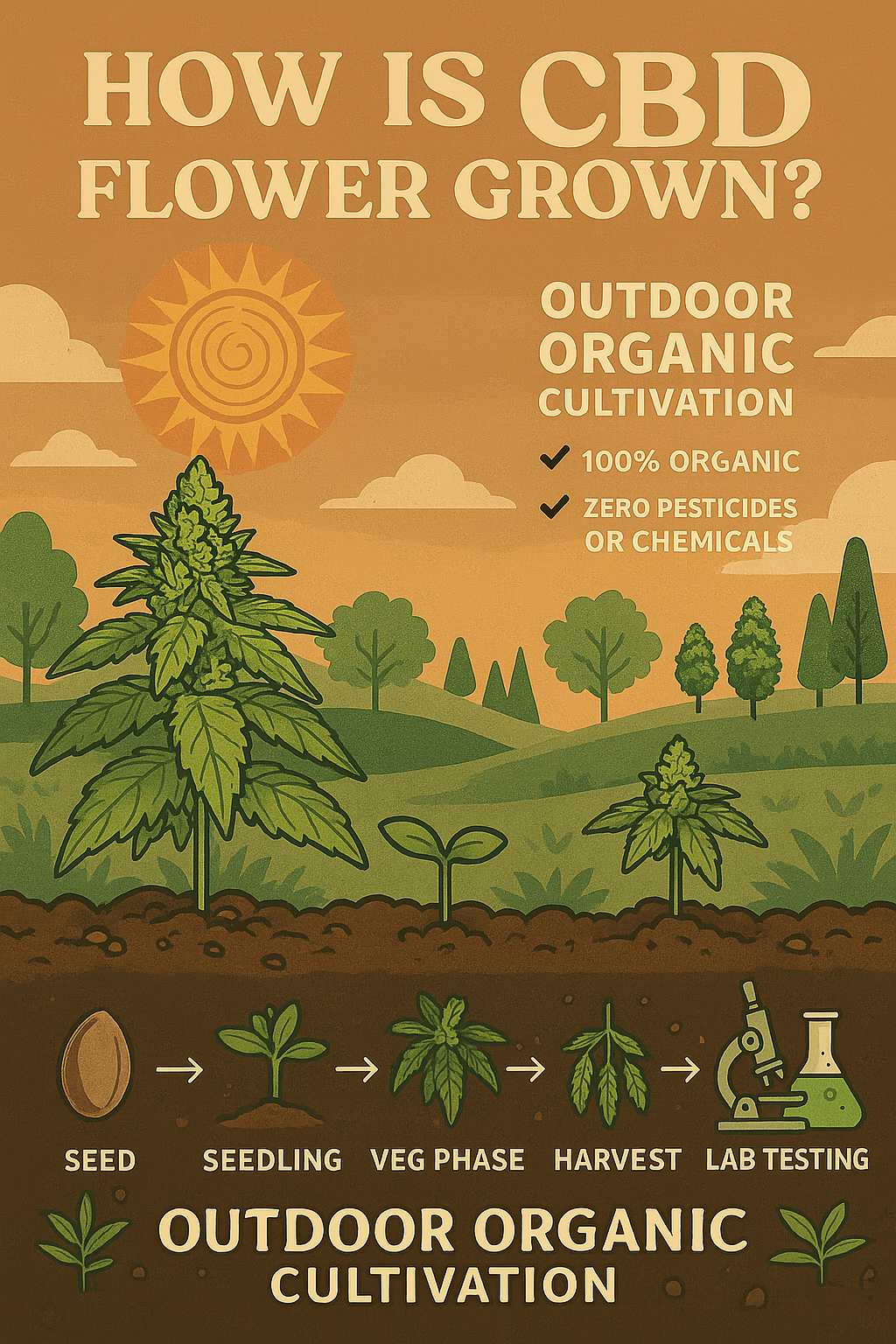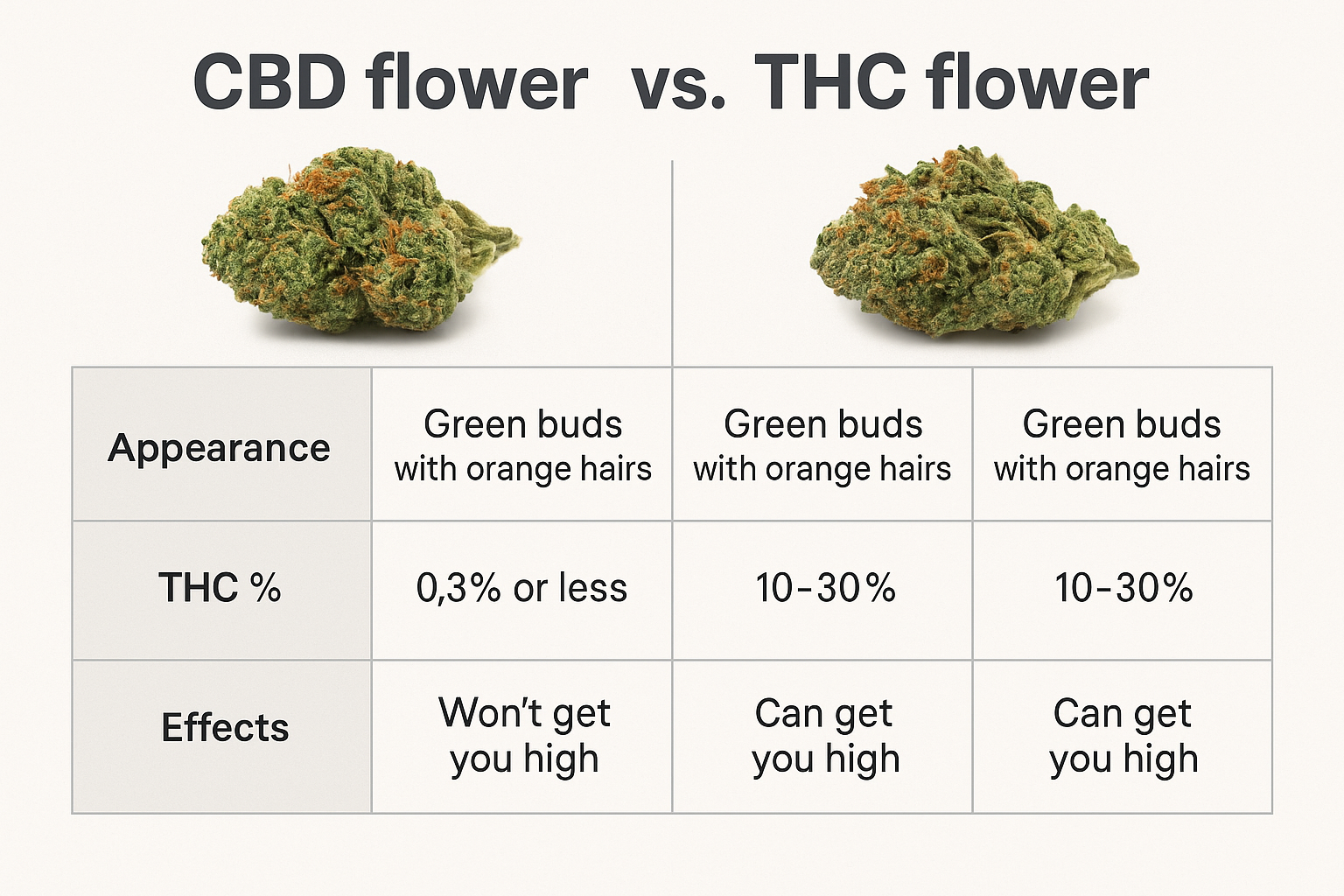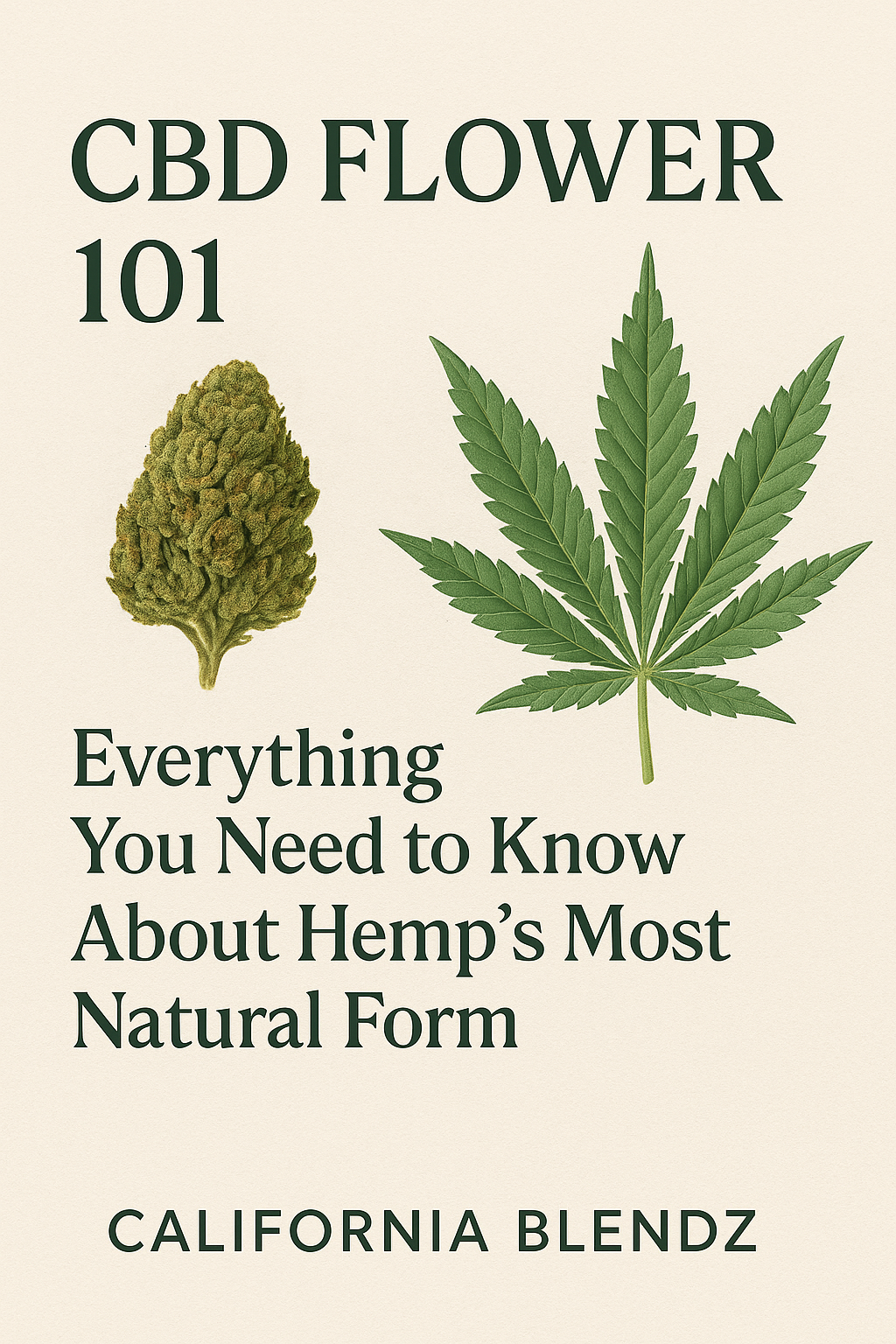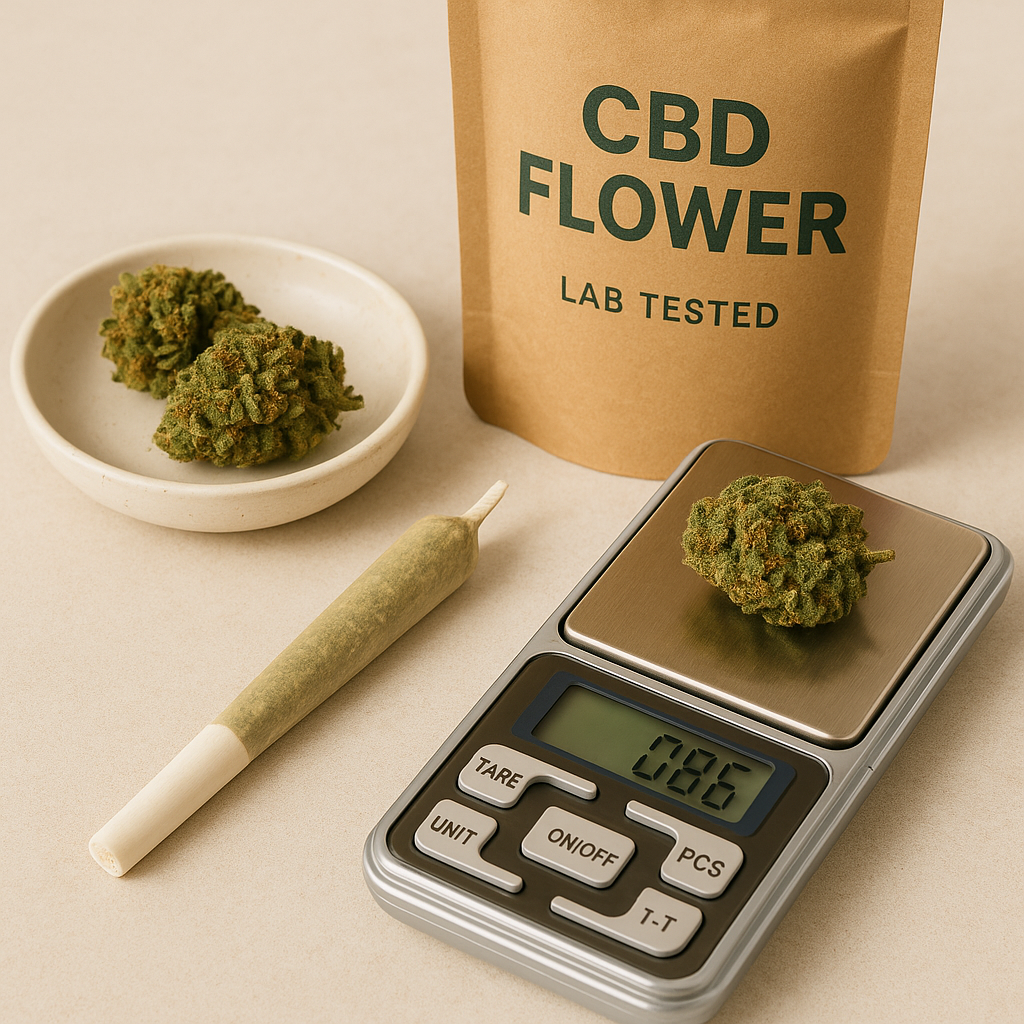Where Does CBD Flower Come From?
Written by California Blendz

Where Does CBD Flower Come From?
CBD flower comes from the female hemp plant, a variety of Cannabis sativa bred to produce high levels of cannabidiol (CBD) and less than 0.3% THC. Unlike marijuana, which contains high THC levels, hemp is non-psychoactive and federally legal in the U.S. CBD flower is harvested from mature buds rich in trichomes, the resinous glands that contain cannabinoids and terpenes.
When you light up a CBD pre-roll or grind a fresh nug of CBD flower, you're enjoying the final product of months of careful cultivation and if you’re smoking California Blendz, that flower has roots in one of the most legendary cannabis regions in the world: the Emerald Triangle. See how we grow our flower organically in California
But what exactly is CBD flower? Where does it come from, and what makes one bud better than another? Let’s dig into the science, the soil, and the story behind premium, small-batch CBD flower — California Blendz style.
Quick Summary
- CBD flower comes from the female hemp plant, bred for high CBD and low THC (≤0.3%).
- California Blendz grows its flower organically in the Emerald Triangle using sun, soil, and legacy knowledge.
- Harvest timing is judged by trichomes, aroma, pistils, and lab testing.
- Lab-tested, slow-cured, and hand-trimmed — our flower is the real deal.
- CBD-dominant hemp varieties must contain no more than 0.3% THC by dry weight, as defined by the 2018 U.S. Farm Bill, making them federally legal and distinct from marijuana.
What Is CBD Flower?
CBD flower is the dried bud of the hemp plant, specifically the female hemp plant bred to be high in cannabidiol (CBD) and naturally low in THC (≤0.3%, per federal law). It looks, smells, and smokes just like traditional cannabis flower, but without the high. That’s because CBD is non-psychoactive, meaning it won’t get you stoned — just calm, relaxed, and clear-headed. What CBD flower is best for sleep?
Interested in CBD? Read our beginner-friendly CBD 101 guide
CBD Flower Starts in the Ground — Why the Emerald Triangle Matters
At California Blendz, all of our CBD flower is sun-grown in the Emerald Triangle and surrounding areas — a storied region made up of Humboldt, Mendocino, and Trinity counties in Northern California.
Why does that matter? Because this region is world-renowned for producing some of the best cannabis and now, hemp on Earth. Here’s why:
Perfect Climate for CBD
- Mediterranean-like conditions: warm days, cool nights, and wet winters mimic cannabis’s natural growing environment.
- Long growing season: Our plants have the full outdoor cycle to reach peak maturity.
- Cool night temps: boost terpene and cannabinoid production for better flavor, aroma, and potency.
Rich, Loamy Soil
- Many of our grow plots sit on nutrient-dense, living soil — a complex ecosystem of microbes, fungi, organic matter, and earthworms that support plant health naturally.
Clean, Natural Water
- Our flower is irrigated with mountain-fed springs and creeks, ensuring no chemical buildup or nutrient lockout from over-treated water.
Legacy Knowledge
- Our farmers have decades of experience, many coming from families who’ve grown cannabis in this region since the 1970s.
Remote, Elevated Plots
- High-elevation farms mean better UV exposure and fewer pests — which means stronger, more resinous buds with no need for pesticides.

How CBD Flower Is Grown at California Blendz
We source organically, outdoors, and with intention. Every plant starts from feminized seeds and is nurtured using regenerative, chemical-free practices.
Our Organic Growing Principles:
- Living Soil: rich in microbial life, not sterile like commercial mixes
- No synthetic fertilizers or pesticides: we feed the soil with compost teas, use cover crops, and employ companion planting to boost health and biodiversity
- Sun-grown: No artificial lighting — just nature doing its thing
The CBD Hemp Flower Grow Cycle
Growing CBD flower isn’t just throwing seeds in dirt — it’s a 12–16 week journey of careful observation, hands-on care, and patience.
Germination (3–10 days)
Seeds sprout and send down taproots. We start them in warm, moist conditions.
Seedling Stage (2–3 weeks)
Young plants develop their first “true” leaves. At this stage, they’re delicate and need precise watering and sunlight.
Vegetative Stage (4–8 weeks)
Rapid growth — branches, leaves, and roots expand. Plants soak up nutrients and sun.
Flowering Stage (6–10 weeks)
Triggered by shorter daylight hours in late summer, the plants shift focus to bud production. This is where the CBD and terpene profiles develop.

🌿 Our Best-Sellers, Trusted by Thousands
Join 5,000+ happy customers who trust California Blendz for clean, craft-grown CBD. Pre-rolls and jars go quick — don’t miss your favorite.
Shop Pre-Rolls & FlowerHow We Know It’s Time to Harvest
Timing harvest is a science and an art. Here’s how we ensure our flower is at peak CBD potency and terpene aroma:
Trichome Color
Trichomes are the tiny, crystal-like resin glands on cannabis buds that contain the plant’s most valuable compounds — cannabinoids like CBD and aromatic terpenes. Under a magnifier or jeweler’s loupe, these trichomes change appearance throughout the flowering phase, moving through three main stages:
- Clear: Trichomes are fully formed but still immature. At this stage, CBD levels are low, and the plant hasn’t reached full potency.
- Cloudy/Milky: The trichome head turns opaque as it fills with cannabinoids and terpenes — this is the peak moment for CBD content. Terpenes are also nearing their highest expression before they begin to degrade.
- Amber: Cannabinoids begin to degrade, and CBD starts converting into other compounds like CBN, which may be more sedative but less effective for certain benefits.
Why harvest at the cloudy stage?
Lab-Tested. Hand-Selected. 100% Real.
78% of customers say lab results are a must. Ours are full-panel tested and always transparent.
Browse CBD Flower Strains- Highest CBD potency: Lab studies and farmer experience show that CBD content is maximized when trichomes are milky, just before they begin to oxidize.
A 2021 study published in Frontiers in Plant Science confirmed that the peak concentration of cannabinoids, including CBD, occurs when glandular trichomes shift from clear to cloudy during flower maturation. This window also aligns with the highest preservation of terpene content under natural drying conditions.
- Terpene preservation: Terpenes are volatile and sensitive to heat, light, and time. Harvesting too late means losing the aromatic and therapeutic value.
- Balanced effect: Milky trichomes offer a well-rounded experience — calm and clear-headed — without the heavy drowsiness often associated with late-harvest amber trichomes.
Terpene Aroma
While trichomes show us the visual signal, terpenes tell us through smell when a CBD flower is at its aromatic and therapeutic peak.
Terpenes are volatile organic compounds responsible for the scent, flavor, and some of the effects of CBD flower. Compounds like myrcene, limonene, linalool, and caryophyllene not only shape the flower’s nose but also influence how it interacts with the body — calming, uplifting, or grounding the user.
Why Aroma Tells You It’s Time
- Terpenes are volatile, meaning they evaporate easily with time, heat, or light. That means the flower’s smell is most intense right before the terpenes begin to degrade.
Research shows that common terpenes like myrcene, limonene, and linalool begin to degrade at temperatures as low as 70°C (158°F), making precise harvest and post-harvest practices critical for terpene preservation.
- When a plant reaches full maturity, you’ll notice:
- Richer, louder aroma — pungent, fruity, floral, earthy, spicy, or citrusy
- Sticky, oily resin on the flower — a tactile sign that terpenes are active and abundant
- This aroma crescendo signals that the terpene profile is peaking, and harvesting now preserves the most nuanced flavors and therapeutic effects.
The Risks of Waiting Too Long
- Degraded terpenes = muted flavor + diminished effects
- Delayed harvest leads to oxidation, where terpenes and cannabinoids break down, often resulting in a flat or hay-like smell and a less effective flower.
Our Practice at California Blendz
We harvest when each strain’s signature scent is unmistakably present — whether it’s the fruity punch of Super Purps or the sweet pine of Sour Hawaiian Haze. Our farmers do literal “nose checks” in the field, backed by years of experience and lab results to confirm that peak aroma = peak flower quality.
When we say you can smell the difference, it’s not just marketing — it’s terpene science.
Lab Testing
- Sometimes lab-tests are done to early samples to confirm CBD levels and terpene profiles before harvesting the full crop.
Pistil Color
While trichomes and terpene aroma give microscopic and sensory cues, pistils provide a quick, visible signal of a flower’s overall maturity. These tiny, hair-like structures emerge from the calyxes of female hemp flowers and play a key role in reproduction — but they also serve as one of the best macro-level harvest indicators.
What Are Pistils?
Pistils are the reproductive organs of female cannabis and hemp plants. When the plant is early in bloom, the pistils appear white, wispy, and upright, reaching outward in search of pollen from a male plant. As the plant matures, the pistils oxidize and darken, gradually curling inward and turning orange, amber, or brown.
Why 70–90% Darkened Is the Sweet Spot
- When 70–90% of pistils have darkened and curled, it means:
- The plant has reached sexual maturity and is past the peak window for pollination.
- The bud has fully developed, and the resin glands (trichomes) have likely reached peak cannabinoid content.
- The terpene profile is nearing its full aromatic potential.
- This range gives growers a balanced harvest point:
- At 50–60% darkened, the plant is close but may not be as potent or flavorful.
- Above 90–95%, degradation may begin — buds may become overly sedative or lose clarity in effects due to rising levels of oxidized cannabinoids (like CBN).
The Risk of Harvesting Too Early or Too Late
-
Too early (mostly white pistils):
- Lower CBD content
- Flatter aroma
- Smaller bud structure
-
Too late (all pistils brown):
- Possible terpene loss
- Increased CBN (more sedative effects)
- Harsh smoke and diminished flavor

From Field to Jar: What Happens After Harvest
The work doesn’t stop when the plants are cut.
Drying
The buds are hung upside down in a cool, dark, ventilated space to remove moisture slowly and preserve aroma.
Curing
Once dry, the flower moves to airtight containers for the curing process — sometimes for weeks — to enhance flavor, smoothness, and potency.
Trimming
After curing, buds are trimmed by hand to remove leaves and stem matter.
Packaging
Everything is vacuum-sealed and lab-tested before it ever reaches your grinder or bowl. View our Certificates of Analysis (COAs)

Lab-Tested & Transparent — Every Time
At California Blendz, transparency is everything. All of our CBD flower is:
- Third-party tested
- Grown organically
- Free of pesticides, heavy metals, and residual solvents
You can see all our lab reports on our COA page.
Why It Matters Where Your CBD Flower Comes From
Most commercial hemp is grown for scale — machine-harvested, sprayed with pesticides, and often lacking flavor or effect.
According to the Brightfield Group’s 2024 CBD Consumer Report, 78% of users prefer organically grown flower, and 65% say they only purchase CBD products with third-party lab results or full-panel COAs.
California Blendz does it differently:
- We grow for quality, not quantity
- We treat the plant with respect, not as a commodity
- We smoke what we sell — and we’re picky
Frequently Asked Questions
1. What is CBD flower made from?
CBD flower is the mature bud of the female hemp plant (Cannabis sativa) that has been bred to produce high cannabidiol (CBD) levels and less than 0.3% THC. It is harvested at peak trichome and terpene development.
2. Is CBD flower the same as marijuana?
No. While both come from the cannabis plant family, CBD flower is legally classified as hemp and contains less than 0.3% THC, meaning it does not produce a high. Marijuana typically contains 10–30% THC.
3. Does CBD flower actually do anything?
Yes. Many users report that CBD flower helps promote relaxation, mental clarity, and reduced physical tension. Effects vary based on strain, terpene content, and dosage, but studies show CBD interacts with the body’s endocannabinoid system to support balance and homeostasis.
4. How is CBD flower different from CBD oil?
CBD flower is the raw, smokeable form of hemp — rich in cannabinoids and terpenes. CBD oil is typically extracted from flower and processed into tinctures or capsules. Flower offers faster onset and a full-spectrum entourage effect.
5. Is CBD flower legal?
Yes — CBD flower derived from hemp is federally legal in the United States under the 2018 Farm Bill, as long as it contains no more than 0.3% THC. Some states may have restrictions on smokable hemp, so always check local laws.
6. How can I tell if CBD flower is high quality?
Look for flower that is:
- Lab-tested with full-panel COAs
- Grown organically and hand-trimmed
- Rich in visible trichomes and aromatic terpenes
- Free from pesticides or chemical additives
At California Blendz, all our flower checks these boxes and more.
Key Takeaways
- CBD flower comes from the female hemp plant, bred for high CBD and low THC.
- At California Blendz, our flower is sun-grown in the Emerald Triangle using organic, small-batch methods.
- From seed to harvest, we monitor soil health, terpene development, trichome color, and lab results to make sure you’re getting the absolute best.
- You can taste the difference in every jar.
Ready to Experience the Real Deal?
🌱 Try the Flower That’s Changing the Game
Grown with sun, soil, and soul — California Blendz CBD flower is organically cultivated, hand-trimmed, and lab-verified for purity and potency.
Experience Real CBD FlowerSources
- Livingston, S. J., Quilichini, T. D., Booth, J. K., Wong, D. C. J., Rensing, K. H., Laflamme-Yonkman, J., & Page, J. E. (2021). Cannabis glandular trichomes alter morphology and metabolite content during flower maturation. Frontiers in Plant Science, 12, 713541. https://doi.org/10.3389/fpls.2021.713541
- McPartland, J. M., & Russo, E. B. (2001). Cannabis and cannabis extracts: Greater than the sum of their parts? Journal of Cannabis Therapeutics, 1(3–4), 103–132. https://doi.org/10.1300/J175v01n03_08
- Brightfield Group. (2024). CBD Consumer Insights Report Q2 2024. Retrieved from https://www.brightfieldgroup.com
- U.S. Congress. (2018). Agriculture Improvement Act of 2018 (2018 Farm Bill), Pub. L. No. 115–334, § 10113. https://www.congress.gov/bill/115th-congress/house-bill/2/text
About California Blendz
California Blendz is a West Coast cannabis brand rooted in transparency, education, and premium-quality CBD flower. We work exclusively with expert cultivators in legendary regions like the Emerald Triangle and Southern Oregon, areas known for clean practices, organic growing, and legacy-level genetics.
Every strain we offer is smoke-tested by our team, backed by full-panel lab results, and hand-trimmed for quality you can see, smell, and feel. We don’t accept anything we wouldn’t proudly roll ourselves.
Whether you’re brand-new to CBD or a seasoned connoisseur, we help you experience the real — no hype, just high standards and top-shelf flower.
Last updated: July 2025
